“Increasing Student Self-Direction” was a webinar presented by Rachel Mark as part of the 2020-2021 UVM Tarrant Institute Professional Learning Series. We present it here in its entirety. You can either watch the webinar recording, listen to an audio version, or read the annotated transcript. Follow-up questions about self-direction in your classroom? Email rbmarkvt@gmail.com.

Audio-only version
Resources
- Increasing student self-direction (slideshow)
Annotated Transcript
Why self-direction?
My name is Rachel Mark. I have been a professional development coordinator for the Tarrant Institute for Innovative Education at the university of Vermont for five years now.
Prior to that, I was a middle school teacher in the southern part of Vermont. I taught sixth and seventh grade, many different subjects, for 16 years.
I‘m also a doctoral student at the University of Vermont working towards a degree in educational leadership and policy studies. And through my work on that degree I have been engaging in a number of different research projects related to self-direction for students in middle school. Adolescent students.
A Brief History of Self-Directed Learning in Vermont
The way that really came around to be was that in 2013, the Vermont legislature passed Act 77, which was a really ambitious series of educational reform steps.
And one of the things that moved Vermont towards proficiency-based learning was to differentiate content skills from what the Vermont state Agency of Education calls transferable skills.
Vermont decided to identify a series of very cross-cutting, large-scale skills that were important for all learners. One of those was self-direction. The others were:
- clear and effective communication
- responsible and involved citizenship
- informed problem solving.
Things that I was familiar with as an educator. I had assessed those things before. I had a large sort of background knowledge base to draw upon.
But self-direction felt different to me and felt new.
Self-Direction in the Current Moment
Fast forward a few years, and I’m working with schools on implementing the assessment and teaching of self-direction. I’m starting to see implementation and assessment that really looks different across the different spectrums and different environments.
And I get curious about what self-direction is.
So that became the first sort of seed. And it led to more questions:
- What does self-direction mean?
- What is the history of this concept in education?
- And how do we make that make the teaching of self-direction actionable in schools?
- How do we increase self-direction for students?
I’m by no means an expert. But I’m really an aspiring self-direction person. I love talking about this topic. And I have done a fair amount of research around it. So I consider my knowledge to be emerging.
What Self-Direction Is… And What It Is Not
One of the things that’s most important to me as I start to share what I’ve learned about self-direction is for me to understand that self-direction is based upon the ability for a learner to have choice and selections based on their needs and interests.
That is critical.
So self-direction does not mean that a student follows and completes teacher directions and follows the teacher on their timeline.
Self-directed learners are not by definition, compliant learners. They may be — you may see those two things interacting.
But there are some times when self-directed learners are very uncompliant because they are showing signs that they would like more choice and would like more opportunity to self-direct their learning.
I wanted to debunk that myth because sometimes I am seeing that one interpretation of self-direction is a person’s ability to complete tasks on time. And according to instructions that are provided by a teacher.
That’s really not at all the intent of self-direction. It sometimes could completely backfire!
Self-Direction Emerged from Adult Education
You can imagine that in the sort of mid 1900s, certain educational researchers were curious about what drove adults to continue their education as adult learners. In night school or community college, where people who did not originally get a degree might be expected to go back to get a degree.
And sometimes more informally: what does it look like for adults to learn on their own?
Meet Randy Garrison
One of my favorite resources and models comes from Randy Garrison and his paper in 1997 that identified these dimensions of self-directed learning.
I think they’re really important because they have a lot of application to this idea of self-direction in schools. Garrison first identifies that in order for there to be self-direction, there has to be motivation. Motivation to both enter the learning, and motivation to sustain that learning, and stay with the task.
Those are two separate things.
In addition to that entry — motivation and the importance of motivation — Garrison identifies two other dimensions at work.
One, he calls self-monitoring. That’s really the responsibility you might think of as taking care of what you need to take care of.
And the second is control. Self-management. That to me has a lot more to do with task management.
But they’re really all intertwined. Motivation is the first thing that needs to be there. And then self-monitoring and self-management interact with one another, those three dimensions go into self-directed learning according to his research.
- Motivation
- Self-Monitoring
- Self-Management
Yeah.
Updating Garrison for a 2020 Context: The BEST Toolkit
When we think about self-direction in a more 2020 context, there has been a lot more that’s been developed.
And what we know now is that there are several different components of self-direction, and that the interrelatedness of them is really important.
And that’s where the BEST Toolkit (.pdf) comes in.
BEST stands for Building Essential Skills Today.
And they talk a lot about the inter-relatedness of the components of self-direction. They have five different dimensions of self-direction. These tend to be the five that are currently being used in, in the literature and the research right now.
- Self-Awareness
- Initiative & Ownership
- Goal-Setting & Planning
- Engaging & Managing (the learning process)
- Monitoring & Adapting (to the learning process).
You can see this sort of metaphor of braided and threaded strands.
When the learner is emerging in their ability to be self-directed, those things seem a little disparate and disconnected.
But as the person becomes more proficient, they sync together in a better way.
What’s important about the braided visual is just imagining how these things are all very inter-related and actually dependent upon one another. In my opinion, that’s one of the reasons self-direction is so fascinating: it’s so often hard to tease these pieces apart.
Unpicking the Braid
Within the dimension of self-direction, we’re really wanting the learner to be asking:
What am I learning about myself as a learner?
For them to have that self-awareness that is very important. We want the learner to be thinking:
How can I integrate my personal interests into how I approach new learning?
So thinking about that — what they know about themselves and that self-awareness — how do they integrate that into learning opportunities and situations within goal setting and planning?
We also really want the student to be asking:
How can I break down a complex task and develop concrete steps to accomplish it?
Sounds Simple, Right?
So how can we help students plan out steps and develop goals and establish really meaningful learning targets for themselves?
We want them to be asking,
“What am I learning about locating resources, managing my time and seeking help when I need it?”
That’s about the sort of managing of the process and the learning experience. And then the monitoring and adapting that needs to happen all along that student is we want them to be asking themselves,
“Am I able to see when something isn’t working well, adjust my approach and learn from my missteps?”
There’s a way in which self-awareness informs all of these dimensions. In some cases, people who are wanting to increase self-direction for their students start with self-awareness because it seems so foundational.
“Dimensions of Self-Direction”
One of the other most common places that we’re seeing resources around teaching self-direction is from the essential skills and dispositions document that was published by the center for innovation in education and the educational policy improvement center.
They use the same five components there.
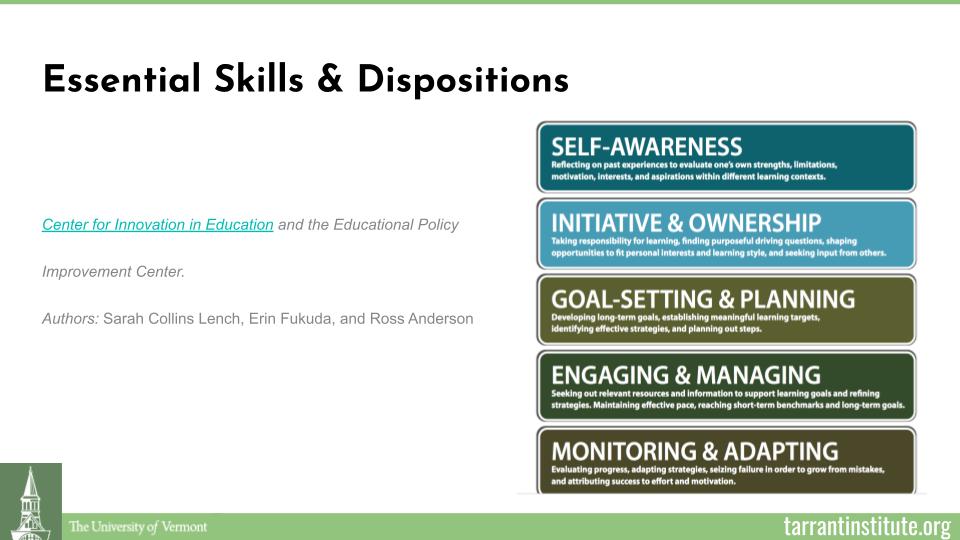
It’s just interesting to look at these two documents that I think are the most helpful in supporting schools and teachers. And it’s interesting to note that they use the same sort of five components or five different dimensions.
Gerald Grow’s Differentiated Teaching Model of Self-Direction
One of the things that really strikes me about self-direction is that it requires teachers to have an understanding of where a student’s readiness is for self-direction.
And so we have learned through the research that there’s really a continuum of readiness for self-direction.
What strikes me about self-direction is that because our learners are at different levels of readiness, our teaching to each of those learners must be different. There’s no one strategy that’s going to work for everyone in your class. Just like we differentiate all of our content for students, when we are teaching, we need to differentiate our opportunities for self-direction.
Gerald Grow’s work emerged in the 1990s out of higher education. He was a professor of journalism, and he started to become really curious about the way in which his college -evel students were compelled to be self-directed.
So he identified these four different stages.
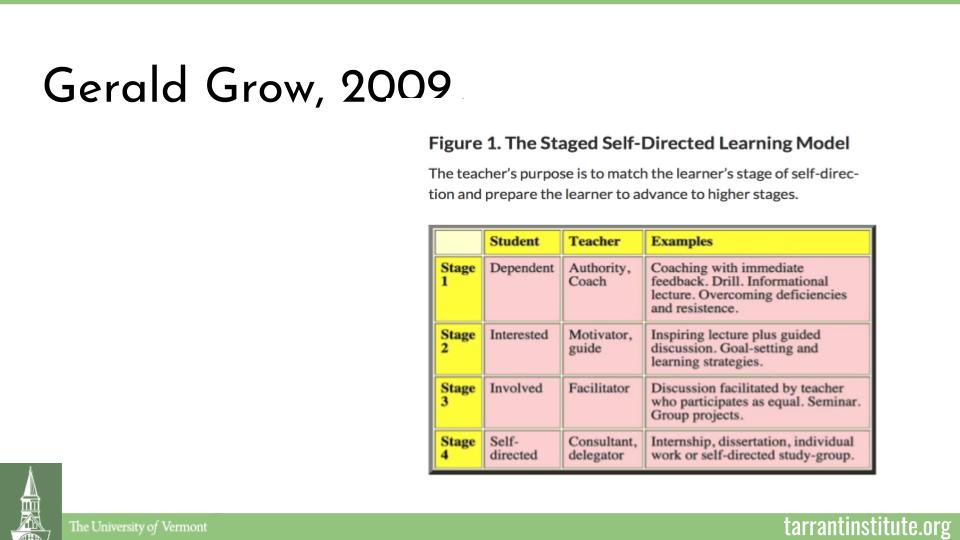
What I think is interesting about this is that he’s identified what type of teaching really needs to match the learner’s stage of self-direction.
So if you have a stage one, dependent learner, that learner at that stage needs someone to be authoritative and coaching, and they need to get coaching with immediate feedback. They need to get informational lecture.
And that’s very different than a student who’s at stage four, who is self-directed. That person needs a teacher as a consultant. That person needs to be engaging in work that looks like internships, dissertations self-directed study group or individual group.
Those are the two extremes.
And then we have people at stages two and three, and those people also need a different type of teaching to match their learning. Grow argues that in order for the learner to advance to the self-directed stage, stage four, they need to receive the best type of teaching for the stage that they’re at along each step of the way.
Match and Mismatch Between Learner Stages and Teaching Styles
I hope you can see that when there is a match between learner stages and teacher styles, things will kind of jive and flow and work well. In this second figure by Grow, those green areas show you the areas of complete match, or near match.
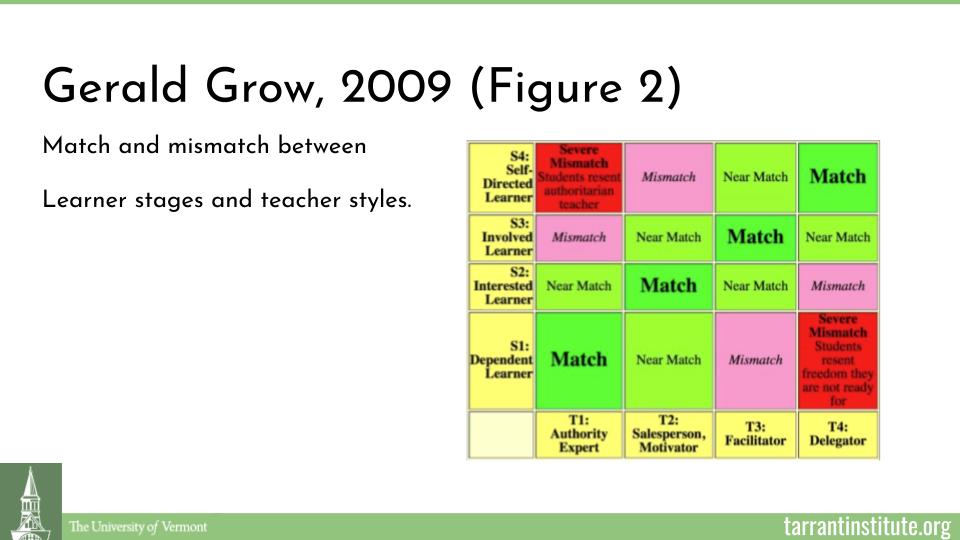
So for example, if I’m an interested learner at stage two, and my teacher teaches with a style of facilitation or in a facilitator mode? That’s a pretty near match.
And what I think is so interesting about this is that I can connect back to my time teaching and think of where I saw this, you know, in a scenario.
Let’s say that I’m the teacher and I teach like this teacher one level: I’m the expert, I’m the authority, everything’s in my control, I’m lecturing. I’m giving all the instructions and not allowing for students to have any sort of involvement or responsibility.
If I have a self directed learner who’s at stage four in my class, that student is going to be pretty frustrated.
They’re going to feel like they resent this style of teaching, where the teacher’s the authority.
At the other end of the spectrum, we might have a learner who is very dependent. They don’t know how to do some things for themselves. And if the teacher teaches at this other end of the continuum where they’re a delegator and saying, “What? Go study what you want to know!” Or, “You can learn about anything you want to learn about during the next 30 minutes!” That dependent learner is going to be also very frustrated because they’re being given freedom that they’re not ready for. They’re being asked to do things that they don’t understand how to do.
Equity & Self-Direction
The interesting pieces that I have been drawn to as I’ve conducted research about self-direction is I’m wondering if and how we give our learners equal opportunities to develop self-direction.
And it turns out that there are some pretty major concerns around how students have equitable access to self directed learning opportunities.
There’s a particular study out of Europe that found that that teachers actually do some of the thinking for less self-directed children, and the children that already have high levels of self-direction received even more opportunities to practice self direction. So the implication of this is that teachers can behave in ways that actually encourage some students to develop self-direction and discourage other students from developing self-direction.
How Do We Increase Self-Direction for All Students?
What’s important to understand is what some of these things look like in the classroom.
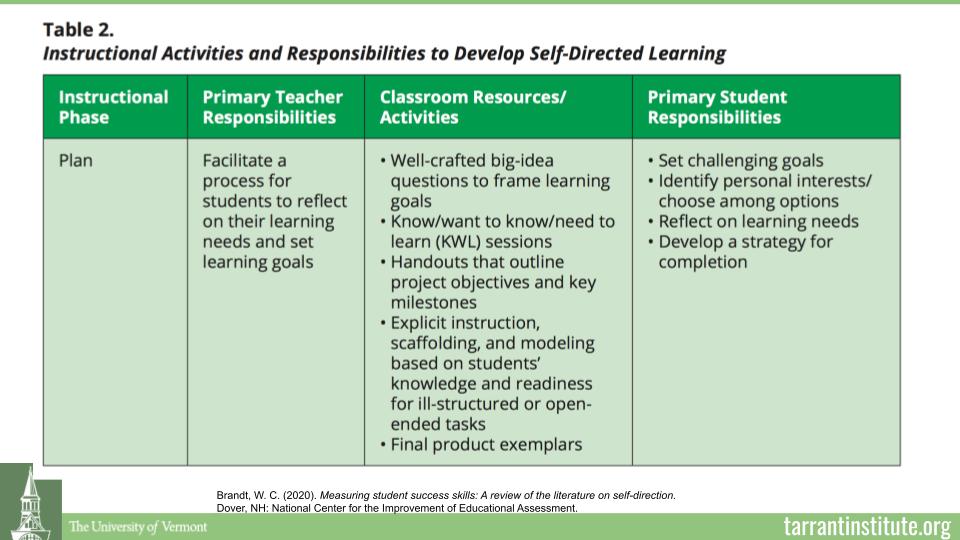
There’s a lot of talk about planning, in terms of developing self-direction. And so if we want to teach our students how to plan, some of the things that can happen are giving people questions to frame learning goals, engaging in something like a KWL (what do you want / what do you know / what do you want to know?) Explicit instruction about and modeling based on students’ knowledge and readiness for open-ended tasks.
And so while teachers are conducting those activities, we are developing the student’s responsibility to be able to set goals, identify personal interests, reflect on learning needs and develop strategies for completing a learning task.
Some of the other instructional phases that we heard discussed in the dimensions of self-directed learning are around monitoring and adjusting.
Appropriate Classroom Activities for Self-Direction
So again, if the goal is for students to monitor and adjust, some appropriate classroom activities might be:
- giving very clear teacher and peer feedback
- having students self-assess
- assess using some brainstorming strategies or whiteboards to make students thinking visible
- doing journaling with some prompts to get student explanations out there.
And that’s so the teachers can be modeling how people monitor learning, and adjust as they move through learning tasks. We hope that as a result of that, students will be able to monitor progress, engage in self observation and really be cognizant and critical about how their learning process is going as it’s happening.
We know that another instructional phase is reflecting and evaluating. That comes down to some of the classroom resources around assessment and reflection. Showcases and presentations, for instance, so that students see that there’s a real utility for their work and an opportunity to share it with other people.
A Learning Scale for Self-Direction
My colleague Emily Hoyler and I developed a learning scale that is based upon three indicators for how teachers can develop self-direction in their learners.
First we think the environment is important. The learning environment is helping develop self-direction.
We described that indicator as that teachers will create a learning environment and design learning experiences where students can practice self-awareness. They can take initiative and take ownership of their learning. There has to be an environment for self-direction where students have opportunities and self-direction is valued. That cannot be overstated.
The next two indicators build off of that.
The second indicator is around structures and processes that you have for self-direction. So again: how is your teaching helping to provide opportunities and scaffold a process for students to make learning plans, reflect upon and monitor their progress and adjust their strategies?
And the third indicator is around curriculum and instruction.
How am I as a teacher, creating learning experiences that encourage students to take initiative and ownership, locate their own resources, manage their time and seek help when needed?
I share this with you because it’s a great tool for you to use as you investigate your own teaching. AS you think about how you might have some strengths in teaching for self-direction, and you might have some areas for growth.
And then what do you do with it?
After you have determined some growth areas, you might look for ways to improve it.
And we have lots and lots of teaching strategies related to self-direction and resources in a self-directed learning toolbox.
Again, in our toolbox are three learning indicators:
- learning environment structures
- processes
- curriculum.
So, for example in the area of learning environment, there’s a prompt about: how do we talk about mistakes in my classroom? Because there’s certainly an amount of risk-taking that’s necessary in order for self-direction to exist and develop. Which means we need to normalize mistakes and have a belief system where mistakes are part of the culture of learning.
On Choice Boards, Hyperdocs, and Playlists
So I wanted to address a couple of particular strategies that are you know, enjoying a lot of attention right now.
I want us to consider how choice sports HyperDocs and playlists support self-direction.
So. HyperDocs!

HyperDocs, they’re basically a Google Doc that is created as not just links out to resources, but as an instructional sequence, if you will, to let the learners know what they actually need to be doing with those resources. It’s providing a frame and instructional steps through links out to content and what students are supposed to then go ahead and do it.
So, HyperDocs, choice boards and playlists are all enjoying some notoriety right now in our educational spaces. They are great tools. They are lovely tools, because they look pretty, they are assembled along a theme or a particular skill that needs to be developed. And they do allow students — in almost all cases — to progress at their own pace. Pacing is something that has been really impacted by using tools like this.
What I want to make sure is that if we use choice boards, HyperDocs or playlists to encourage and develop self-direction, then they need to be more than just a set of instructions. There needs to be an element of choice. (Believe it or not, I have actually seen choice boards that don’t have any choice.)
We also use the word “menu” sometimes, and that’s a similar structure, but a choice board is more than just saying, do this, do this, do this, do this, do this, and do that at your own pace until you’ve mastered the information.
There needs to be choice.
There needs to be a place where you say:
“Do this if you need to learn more about this, or do this other thing if you’re interested in this other topic.”
I can’t overstate the importance for choice in these three different structures that are similar. So students are making choices.
They’re also given the opportunity to make decisions about the content, and about the learning process based on what they know about themselves and their needs as a learner and their personal interests.
Another kind of critical component to any of these processes or structures is that there’s a reflection component for students. A place where they can practice and exercise some metacognition about:
- How is it going?
- Did I make the right choice?
- Did the choice I made in my learning process help me understand this better?
- Or did I make some wrong choices?
And now I know more about myself!
Final Thoughts on Self-Direction
My final thought I want to leave you with is that I can’t overemphasize the importance for us to be providing *opportunities* for self-direction in order for our students to demonstrate and develop self-direction. Without opportunities, how can students even try?
I really think that we can start that as early as possible in our schools. There are probably classrooms of kindergartners and first graders that are doing that really well. It makes me think about going into my children’s kindergarten class and seeing those different centers that students can choose and go to. They’re using self-direction to do that.
Q & A Session
Question on Self-Direction & Proficiency-Based Assessment
“This is perhaps custom to the Vermont context, but I’d like to ask you about self-direction and assessment. Self-direction is something we’re being encouraged to assess in students, at the same time Vermont’s Act 77 legislation encourages us also to use proficiencies. Can you talk us through maybe a little bit about how you might tie those two concepts together?”
Answer:
So first of all, Vermont does have rubrics that they developed, the Agency of Education has rubrics for different grade bands and they’re sort of what the criteria looks like for self-direction that are supposed to be student friendly. They’re written as “I can” statements. Like “I can locate a resource and determine whether that is a trustworthy source.” That actually is one of that’s part of the criteria of self-direction which seems more like it kind of like bleeds into library media and technology skills too, but that’s because a lot of the emphasis of self-direction is on locating resources and, and managing resources.
Those are a great place to start, but know that the resources that I shared here from the best tool kit that has very good resources also for rubrics.
Self-direction is this really big concept and we as teachers typically give it one space on an assessment, and instead we’d probably be better off diving deeper into the criteria and being really specific about the assessment of that particular part of self-direction.
Like, maybe you are great at self-awareness, but not great at like, monitoring and adjusting as you’re in the process.
I think we need to separate those things out for students so that they can see where their growth areas are and take steps to do better. You know, ironically there, our assessment of their self-direction should inform their self direction in the classroom. It’s a two way street.
Question on Self-Direction & Flexible Pathways
“Are there ways that you can envision self-direction being key for learners to actually take advantage of the opportunity to pursue flexible pathways in their learning?”
Answer:
Absolutely. Those two things are so wedded together.
I believe that aspiration starts in grade seven. There are 14 year olds who don’t know the pathway they want to take because they have not had to exercise that muscle before, of knowing who they are as learners and knowing what choices they’re going to make that will take them in the direction they want to go as learners.
If we’re developing self-direction in students, in primary K to five school and then middle school, grades 6-8, by the time we’re ready for them to go out and enjoy some flexible pathways, they should have a sense of who they are and what they’re interested in. What they want to do.
So my, one of my fears is that we haven’t, in some systems we haven’t introduced self-direction early enough, so that by the time they arrive at the doorstep of the flexible pathway opportunities, they they’ve lost their muscle to know what’s what they want and where they want to go. And they’re like, why are, you know, I kind of think about people that I know and think that, that there’s a kid saying, why are you asking me now what I want to learn about? And so it’s too late, we’ve missed the window and that we needed to have been doing that all along. So that by the time we’ve got a kid who can do an internship off campus for credit they’ve they’re primed and ready hope. That makes sense.
Question on Self-Direction & Project-Based Learning
“In terms of the popularity of project-based learning as a scaffold for, for authentic and meaningful learning opportunities for students, do you see a role that self-direction can play in the PBL cycle? Especially when you have a PBL that’s done in groups and you’re trying to assign the various types of activities, the various responsibilities; is there a way that you can fold self-direction into that as an explicit part of the process?”
Answer:
Well yes.
Self-direction can be reinforced in PBL environments.
Project-based learning environments typically do allow students to have some amount of choice about which kind of angle they’re going to follow of this topic or this theme. There’s a little bit of flexibility in terms of the task itself if there’s project based learning that is in groups. We know when you work in a group, there’s an amount of compromise and collaboration and you can’t just be like, well, I’m in charge and this is what I want to do.
The other piece I would say about project based learning reinforcing self-direction is the fact that project-based learning is building towards a culmination.
There should be some iteration that’s happening, which allows students to be monitoring and adjusting. If I’m building towards a a presentation I’m going to give, I’ve gone through some of the pre stages so that I can see where I need to adjust and maybe I need more research there or something. So I think just that aspect that project-based learning is usually there’s usually some iteration building up to this culminating event, and that takes monitoring on the student end.
Question on The Most Challenging Aspect of Self-Direction
“We know that there is some element of choice and agency that all really great teachers give to their students in the classroom. As educators become more familiar with inculcating self-direction in students, what could you identify as maybe the most challenging aspect of trying to build self-direction in students? What have you perhaps experienced as, as a common challenge for educators trying to build this up, or the research tells us is a challenge in getting started on this process?”
Answer:
That’s a great question. I can think of a few things.
There’s a really fine balancing act that teachers need to walk. That’s where Emily and I came up with our title of our course, “The Sweet Spot”. That’s balancing between them getting there on their own and you helping them get there.

The Sweet Spot
The sweet spot is this just-right grain size of place, where for them to play with what they want to know about in a way that is manageable.
And sometimes it’s really hard to get somebody to that sweet spot, right? If we let kids take on something that’s too big in scope they will get frustrated and fall short and maybe give up. If we let them do something too small in scope, we know that they’ll just finish and not know what to do.
And so there’s a way that teachers can, in their language of coaching help get to something that feels like the right size. One of the things that’s really hard for teachers is to stay in a place of language that promote self-direction. What that looks like is saying:
“Well, what do you think you need to do next? Hmm. Yeah, I hear you. I wonder how you might find a way to solve that? I wonder what tools you have around you to solve that question that you have?”
It takes time to use that kind of language. It takes patience. Sometimes even the most well-intentioned teachers go to a teacher directed place and say, this is what you need to do.
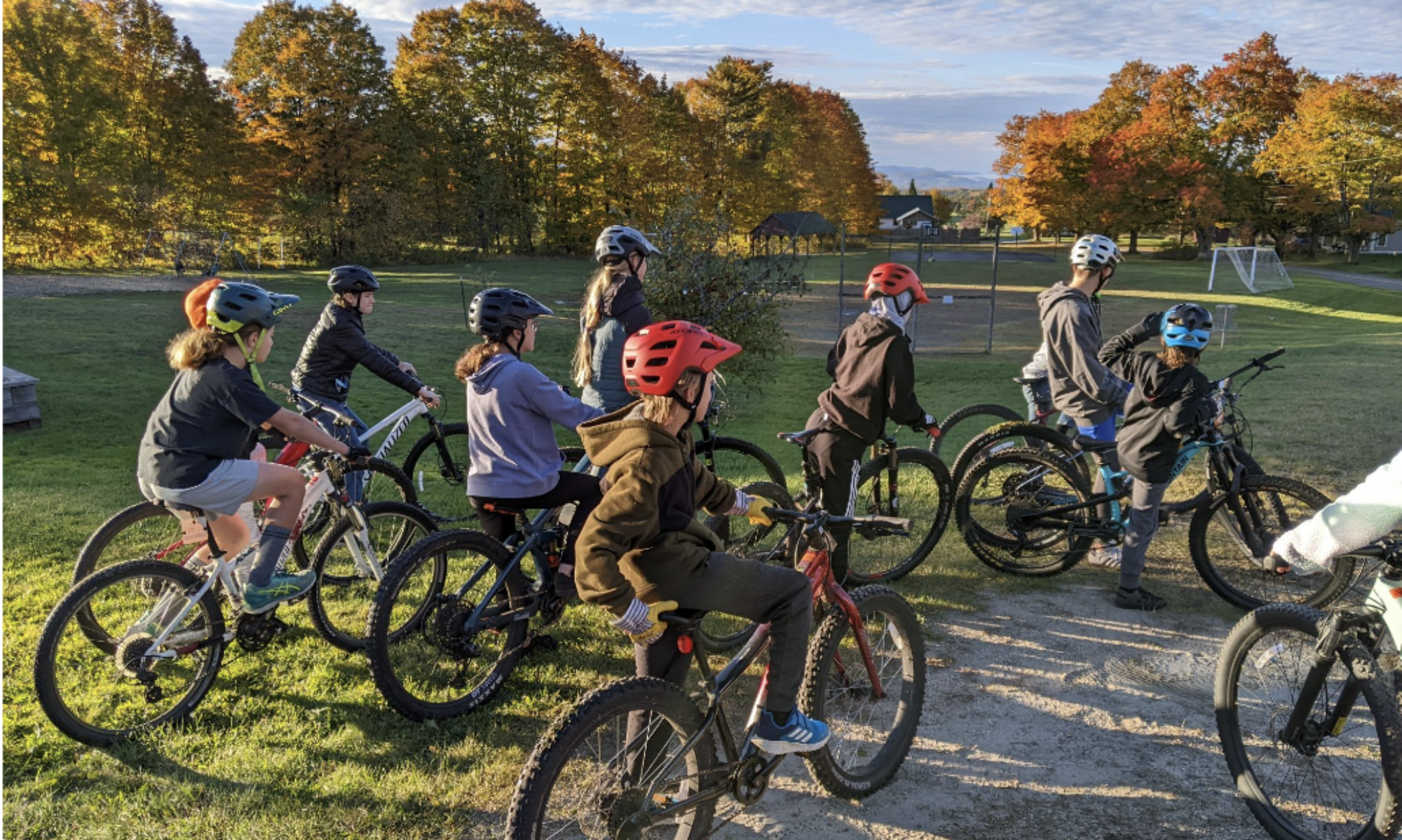


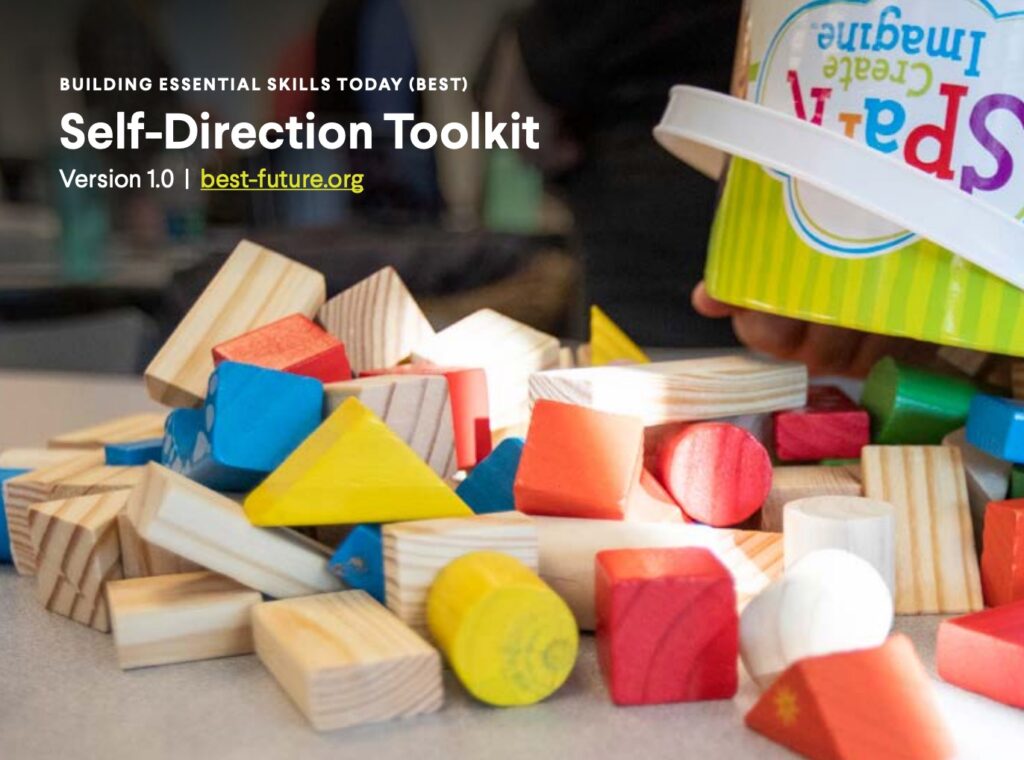
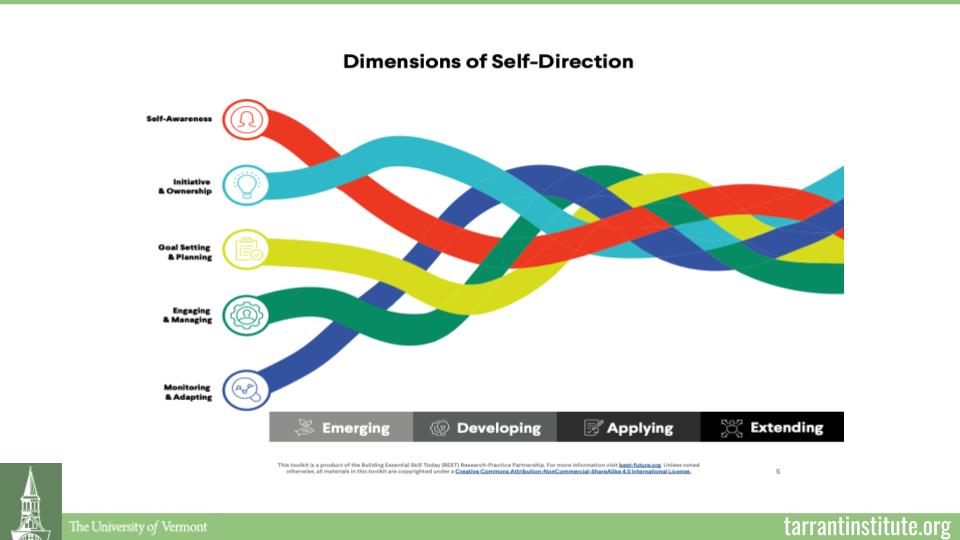
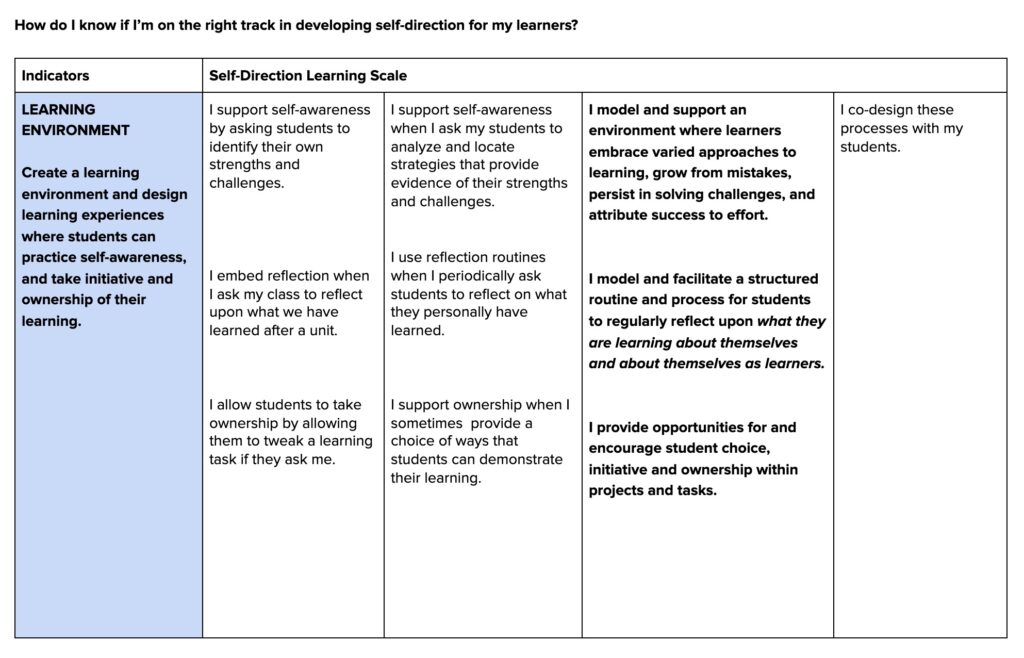
Your point of view caught my eye and was very interesting. Thanks. I have a question for you.